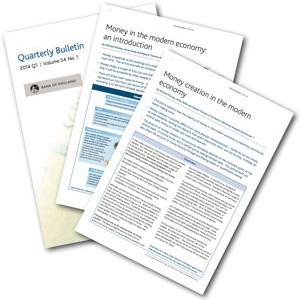What Is the Money Multiplier and How Does It Work
We've seen the two main ideas that the general public have about the way banks work. Both of them are wrong. That's not too surprising, after all, unlike the Positive Money team most people don't spend their time obsessing about how banks work. And banking is complex, which means that most people give up trying to understand it. But what about economics or finance students? Most of these students and graduates have a slightly better understanding of banking. They get taught about something called the 'money multiplier'.
Proof & Further Reading:

Is the 'Money Multiplier a Myth?'
From the Bank of England's 2014 Q1 Quarterly Bulletin:
"Another common misconception is that the central bank determines the quantity of loans and deposits in the economy by controlling the quantity of central bank money — the so-called 'money multiplier' approach. In that view, central banks implement monetary policy by choosing a quantity of reserves. And, because there is assumed to be a constant ratio of broad money to base money, these reserves are then 'multiplied up' to a much greater change in bank loans and deposits. For the theory to hold, the amount of reserves must be a binding constraint on lending, and the central bank must directly determine the amount of reserves. While the money multiplier theory can be a useful way of introducing money and banking in economic textbooks, it is not an accurate description of how money is created in reality. Rather than controlling the quantity of reserves, central banks today typically implement monetary policy by setting the price of reserves — that is, interest rates." (McLeay, Thomas, & Radia, Money creation in the modern economy, page 2)
"In reality, neither are reserves a binding constraint on lending, nor does the central bank fix the amount of reserves that are available. As with the relationship between deposits and loans, the relationship between reserves and loans typically operates in the reverse way to that described in some economics textbooks. Banks first decide how much to lend depending on the profitable lending opportunities available to them — which will, crucially, depend on the interest rate set by the Bank of England. It is these lending decisions that determine how many bank deposits are created by the banking system. The amount of bank deposits in turn influences how much central bank money banks want to hold in reserve (to meet withdrawals by the public, make payments to other banks, or meet regulatory liquidity requirements), which is then, in normal times, supplied on demand by the Bank of England." (McLeay, Thomas, & Radia, Money creation in the modern economy, page 2)
"Part of the confusion may stem from some economists' use of the term 'reserves' when referring to 'excess reserves' — balances held above those required by regulatory reserve requirements. In this context, 'lending out reserves' could be a shorthand way of describing the process of increasing lending and deposits until the bank reaches its maximum ratio. As there are no reserve requirements in the United Kingdom the process is less relevant for UK banks." (McLeay, Thomas, & Radia, Money creation in the modern economy, page 3, footnote 2)
From a Bank of England handbook for central bankers:
"If there is a shortage of liquidity [i.e. reserves], then the central bank will (almost) always supply the need…As regards a shortage of commercial bank reserves held at the central bank, the risk is that a shortage would mean payments could not be cleared at the end of the day." [Our addition in square brackets] (Gray, S., Handbook No. 27 – Liquidity Forecasting. Bank of England Centre for Central Banking Studies. 2008).
From Professor Charles Goodhart, advisor to the Bank of England:
"Virtually every monetary economist believes that the central bank can control the monetary base [i.e. the stock of cash and central bank reserves]… Almost all those who have worked in a central bank believe that this view is totally mistaken." [Our addition in brackets.] Goodhart, C. (1994). What Should Central Banks Do? What Should Be Their Macroeconomic Objectives and Operations? The Economic Journal, 104 (p. 427).
What Is the Money Multiplier and How Does It Work
Source: https://positivemoney.org/how-money-works/banking-101-video-course/whats-wrong-with-the-money-multiplier-model-banking-101-part-2/